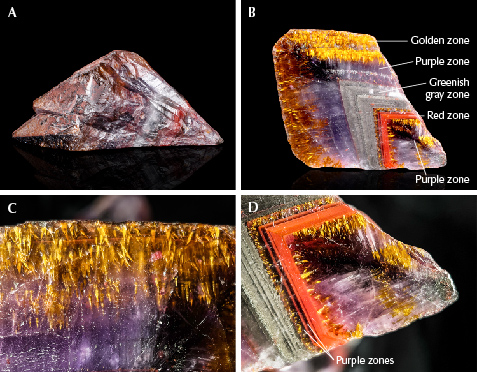A Type of Multi-Colored Quartz with Oriented Inclusions, Reportedly from Brazil

A special quartz called “Auralite 23” in the Chinese trade has recently appeared in the Donghai jewelry market in Jiangsu Province (figure 1). Sellers claim the material is from Brazil. The quartz is very similar to amethyst from Minas Gerais, Brazil (B.M. Laurs and N.D. Renfro, “Amethyst from Brazil with interesting inclusion patterns,” Journal of Gemmology, Vol. 35, No. 6, 2017, pp. 468–469).

Four color zones (purple, red, greenish gray, and a second purple zone) are displayed when observed along the threefold axis. Sometimes, a separate golden zone can be formed (e.g., figure 2, B and C). The purple and greenish gray zones in the upper part of figure 2D are well defined, while the red and purple zones in the lower part show alternating growth bands. After cutting, substantial oriented inclusions can be found in each color zone. Golden “broom-like” inclusions observed in the purple zones are regularly distributed along the growth direction. Greenish gray horsetail-like inclusions are found in the middle of the quartz. In addition, red platelet inclusions appear in the red zone (figure 3). Notably, the platelet inclusions are seemingly restricted to this red zone and thus generate an agate-like zoning.

A multi-colored quartz slice was purchased and researched. The Fourier-transform infrared (FTIR) transmission spectra—with weak peaks at 3584 and 2331 cm–1, medium strong peaks at 2924, 2850, 2671, 2597, 2498, and 2136 cm–1, and strong peaks at 3454 and 2242 cm–1—indicate that this is a natural quartz (figure 4).


Raman analysis identified the typical inclusions in the purple zones, with peaks at 246, 300, 387, 415, 550, and 685 cm–1 as goethite. The red platelet inclusions with peaks at 225, 245, 293, 411, 499, 611, and 1321 cm–1 are hematite (figure 5). The greenish gray horsetail-like inclusions could not be identified by Raman spectroscopy, so we carried out electron probe microanalysis (EPMA). The chemical analysis of these inclusions are mainly iron (45.49–46.51 wt.%) and sulfur (51.34–51.87 wt.%), indicating that they are FeS2 inclusions.
Considering the multi-colored zones and different oriented inclusions, this quartz likely formed and crystallized in multiple stages. However, the origin of this special pattern still remains unclear and is worth further research.
.jpg)


